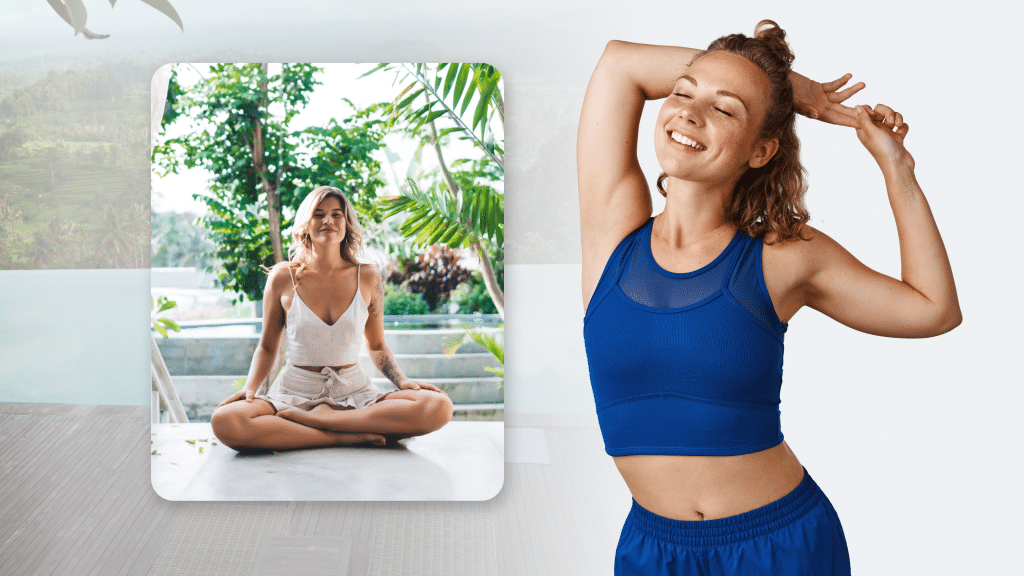It can be embarrassing if you suddenly forget or become unconscious of your environment. Your consciousness of where you are and what you’re doing at the moment is incredibly important and at the same time, it contributes to your effectiveness.
Whether you’re suffering from a lack of self-awareness, depression, stress, or health-related challenges, mindfulness tips can help you become more present and impact your productivity and relationships with others. Having a mindfulness practice can help you become more focused, happier, healthier, and better equipped to manage your psychological and emotional pain.
Mindlessness, or the inability to tune into the present moment, is a global challenge and can be associated with stress and depression. Research on mindfulness has found that stress can negatively affect a person’s physical and mental well-being. It’s associated with an increased risk of autoimmune diseases, high cholesterol, migraines, coronary heart disease, muscle tension, backache, hypertension, anxiety, depression, and other life-altering issues that can threaten a person’s well-being (1).
Those who want to enhance their productivity could benefit from practicing mindfulness, which has been linked with several therapeutic benefits for people who have behavioral health challenges. At the same time, it can help people cope with physical health challenges, including type 2 diabetes, cancer, fatigue, heart disease, insomnia, and psoriasis (1).
What Is Mindfulness?
Research on mindfulness as a clinical intervention defines mindfulness as a way of paying attention to the present experience without being judgmental (2). It’s a kind of meditation.
The American Psychological Association (APA) also defines it as “a moment-to-moment awareness of your experience without judgment” (3). It should be noted that mindfulness is more of a state than a trait. As it’s a state, this means you can master it by practicing.
The Importance of Mindfulness
Mindfulness practice helps you develop greater self-awareness and can help you cope with thoughts that are difficult or unhelpful. It also helps you feel less stressed and calmer, while giving you the ability to choose how you want to respond to your thoughts and feelings.
By practicing mindfulness, you become more conscious of the thoughts that come in and go in your mind and focus more on what your body is telling you, such as when you feel tense or are becoming anxious.
Special health reports published by Harvard Health Publishing on how to harness the power of happiness, mindfulness, and inner strength suggest that there are some benefits of mindfulness, some of which are explained below (4):
1. Improves Your Total Well-Being
When you become mindful, it’s easier for you to manage adverse events, which can improve your well-being (3).
2. Promotes Focus
By being mindful, you can maintain focus. Interestingly, when you’re mindful you’re able to pay attention to details and engage in the moment, which reduces rumination and anxiety. (3).
Running a never-ending rat race, shoving trauma further and further away, falling into self-harming thought patterns, living life that’s eclipsed by constant anxiety and fear – this is what an average person goes through every day. Not addressing it will only pull you deeper into a downward spiral. BetterMe: Meditation & Sleep app will help you gain a new perspective on life and help you regain that long-lost internal balance!
3. Effective Management of Physical Pain and Improved Physical Health
Subjective pain can be better managed through mindfulness. Also, those with chronic pain can manage the situation better (5).
You can improve your quality of life by practicing mindfulness. You can then become more emotionally intelligent when you’re mindful of your emotions as it helps you switch quickly from a negative to a positive emotion.
You can see the world from a better perspective when you’re mindful of your emotions. This impacts how you relate with others. In addition, it can relieve you of chronic pain, high blood pressure, heart disease, the elevation of gastrointestinal difficulties, and even improve how you sleep.
4. Depression May Be Prevented and Treated
According to research, mindfulness-based cognitive therapy (MBCT), is effective for reducing and treating depression. (6).
For example, a study comparing the effectiveness of mindfulness-based cognitive therapy with antidepressant treatment found that MBCT reduced the risk of depressive relapse or recurrence as well as medication. (7).
Another study on the effect of focused meditation training on depression and anxiety symptoms also found meditation to effectively reduce the symptoms of depression and anxiety (8).
5. Promotes Body Satisfaction
Meditation can increase how satisfied you are with your body image. A study was conducted on women of different ages who were suffering from body dissatisfaction. After one group was taken through self-compassion meditation training for three weeks, their body dissatisfaction reduced significantly and their self-compassion and body appreciation also improved (9).
6. Increases Self-awareness
One of the proven benefits of mindfulness is that it helps you become more self-aware (10). In the process, you get to know who you truly are without basing your judgments on events that are happening around you.
Through mindfulness, you gain clarity about their lives and you can overcome anger, doubts, and fears while opening your mind to positive things that impact your overall view of life.
Read more: Somatic Tracking Meditation: Nurturing Inner Harmony Through Mindful Awareness
Tips for Practicing Mindfulness
It is worth noting that practicing mindfulness doesn’t cost anything – you don’t need to buy anything and all you need to do is devote a little time and space to build your skills daily.
Initially, your mind will definitely wander. It’s possible to drift from the present moment to something that happened previously, tasks that are yet to be done, and a host of other things.
When this happens, you don’t need to worry as it’s a process that takes some time to master. The temptation to judge things will set in, particularly if you fall short of your expectations. This is why mindfulness is a practice of returning to the breath repeatedly and reinforcing the ability to do it again. You may ask, “How do I start practicing mindfulness?” Below are some mindfulness meditation tips that can help you:
1. Take Note of Your Thoughts and Emotions
Paying attention to your thoughts and being non-judgmental will help you be more present. Simply pay attention to how your breath comes in and goes out. Feel the sensation and connect with it naturally. A study revealed that when people become mindful of their psychological functions or internal states, such as their breath, this can increase acceptance and memory and lead to more focused attention (11).
2. Start Small and Increase the Pace Every Day
You don’t need to start mindfulness for a long time every day. Research on brief mindfulness meditation in novices found that it can improve their ability to pay attention to demanding tasks, even in short 10-minute sessions. (11).
3. Choose a Comfortable Posture
There’s no hard and fast rule regarding which posture you should maintain when it comes to practicing mindfulness. However, the sitting posture seems to be the most common. You could also choose to lie down or stand up.
Anything that will support your level of alertness and promote ease when practicing mindfulness is the most important thing. If you try out a posture and it doesn’t work well for you, choose another until you find the perfect one.
4. Pay Attention to When Your Mind Wanders
As much as you may try to resist getting carried away by other thoughts or what’s happening around you, you’ll still fall prey to it when you start to meditate. When this happens, all that’s needed is to return the attention to the breath and continue the process.
5. Practice Daily Meditation
Many benefits can be derived from meditation, including increased levels of inner peace, happiness, and energy (12). You don’t need to practice for a long time – approximately 5 to 10 minutes daily can positively impact your life and strengthen your mindfulness muscles.
Explore more tips for daily mindful practices in our previous guide – Mindfulness For Beginners.
Tips for Mindfulness at Work
One of the challenges you may face at work is managing several responsibilities simultaneously. This could range from reading and replying to emails to trying to meet deadlines on urgent tasks. Even when you’re supposed to be on lunch break, some things may require attention, and this can increase workplace stress.
Unfortunately, if all these factors aren’t well managed, you may struggle with poor attention, which lowers your level of productivity.
You may ask, “How can I improve my mindfulness at work?” It’s worth noting that the purpose of mindfulness isn’t about trying to make your head stop thinking about things, but about paying attention to your physical sensations, emotions, and thoughts in order to gain clarity. Therefore, here are a few daily mindfulness tips that can help increase your level of mindfulness at work:
1. Work on One Task at a Time
Multitasking has a way of reducing your level of productivity. When you attempt different things simultaneously, your brain starts to switch back and forth, thereby losing valuable information in the process.
By learning to do one thing at a time, you become more effective as you can give your full attention to what you’re doing, which makes you feel more productive and fulfilled (13) and allows you to let go of work-related stressors.
2. Create a Line of Focus Daily
One of the things that can help you be mindful at work is writing down things you want to focus on for the day. The exciting part of this activity is that it makes you productive and helps you maintain focus.
In addition, you’ll feel powerful, strong, proud, and in control. It also increases your capacity to tolerate pain, reduces unhelpful ruminations after going through a stressful experience, and enhances self-control.
You can stick these tasks on your computer or write them on a notepad. By doing so, you can identify the things that hinder your optimal productivity.
3. Practice Conscious Presence
The hallmark of mindfulness is learning to be aware of things that are happening around you instead of operating in an unconscious state.
When you’re working on a task, it’s possible that your mind will wander. If this happens, you must acknowledge these thoughts and bring your attention back to what you’re doing at the moment. As you consciously work on this, you’ll start to be more present.
4. Acknowledge and Accept Things You Can’t Change
Mindfulness is all about accepting and appreciating the present moment the way it is. For things that are beyond your control or that are impossible to change, it can be tempting to judge them.
So, to practice mindfulness at work, you must first accept the way things are before you attempt to change them. The underlying principle behind this is that anything you don’t accept, you’ll ultimately resist.
In addition, you may become aggressive in your resistance to them, which may ultimately affect your relationship with others and decrease your motivation.
When you practice mindfulness, you don’t focus on how badly your day started, those that wronged you, and all other negative things that may make you feel bad, but instead focus on what’s happening in the moment (14). By doing this, you can direct your energy to the next line of action instead of clinging to what had happened in the past, which is irreversible.
5. Take Time to Meditate and Experience Your Emotions
What do you do when you’re stressed out or feel aggressive? Research by the University of Texas found that bottling up emotions can increase a person’s aggression (15). As much as mindfulness is about tuning into your thoughts, your mind sometimes needs to be clear in order to focus on important things.
Whenever you feel stressed out, take a break for a few minutes and leave your desk to reset your mind. You may need to listen to a podcast or sit outside and get some fresh air before you return to work. This will help you feel refreshed and invigorated when you continue your task.
Something else you can do is to take a minute or two to surf the internet. Go on YouTube to watch puppy videos or do a few non-work related things that can entertain you before you return to work.
6. Be Present in Meetings
It’s almost impossible to go through an entire meeting without chatting online with a coworker, checking your emails, or thinking about something else entirely.
According to research, 91% of people who attend meetings spend their time daydreaming, while 73% do other things during meetings, and 45% feel overwhelmed considering the number of meetings that they’ve attended (16).
To practice mindfulness during meetings, it may be helpful to really listen when someone is talking and be fully present in the conversation. You should avoid opening your laptop, picking up your phone, or staring out of the window, and try to maintain eye contact with the person who is talking. At the end of a meeting, it may be helpful to spend a few minutes recapping the points that were discussed and clarifying what to do next.
Mindfulness Tips Outside of Meditation
Conscious awareness is what mindfulness is all about. The exciting thing is that it’s possible to stop being conscious of the world around us and focus on what’s going on within. Mindfulness is about reconnecting with your body and feeling the sensations it experiences. Through mindfulness, you can clearly be in the moment, which can also affect how you see yourself and your life.
Mindfulness and meditation go hand-in-hand, but they’re not the same. Practicing mindfulness outside of meditation helps the mind manage distracting thoughts. In this way, it becomes easier for the mind to pay less attention to what’s happened in the past or what’s about to happen, which may reduce stressful thoughts. Once that’s achieved, it becomes easier to focus on what’s happening in the present moment, thereby relieving you of stressful and habitual patterns of thought (17).
When these stressful and arbitrary thought patterns are reduced, it becomes easier to make wise choices. Through mindfulness, mental clutter can be reduced more easily. Furthermore, as you become mindful of the present position, it becomes easier to be conscious of your reactive tendencies to pleasant and unpleasant experiences. As you take a conscious breath, you can choose how to respond carefully and wisely (18).
When you don’t have time for meditation, the following steps can help you be mindful (19):
- Focus on Your Breathing
One of the easiest ways to become mindful is to pay attention to your breathing. While you don’t need to sit in a place to meditate for 30 minutes on your breathing, you can do it while you’re on the go – anytime and anywhere. This can be while sitting at your desk in the office, doing laundry work, cooking, doing house chores, or many other activities – as long as it doesn’t take all your attention, you can still practice mindfulness.
You can practice this in whatever position is convenient for you. Notice the way your breath feels, such as the kind of air that comes in, whether it’s cool or warm; the rate at which you breathe, whether it’s slow or quick; how your body naturally responds to the breath, whether your chest or belly rises; and how easy you find the breathing process.
Don’t be judgemental. You’re not trying to change or fix something. What you’re doing is observing your body’s responses. It’s possible that you’ll be tempted to start asking questions or appraise how things are going while this is happening. Don’t feel bad about this, just bring your thoughts back and keep monitoring your breath.
- Practice the 5-4-3-2-1 Grounding Technique
This is another way you can immerse yourself in the present. With this technique, you can become mindful of what your body is experiencing through the engagement of your five senses. Grounding is a way of pulling yourself out of a mental spiral into the present moment through the senses. To practice this, you need to notice five things you can see in your environment.
Depending on where you are, this could be the chairs in your living room, artwork on the wall, plates on the rack, books on the shelf, clothes on the hanger, and so on. You should then take note of four things you can hear. This could be the noise of an opening door, the humming of a rotating fan, or sounds from people talking.
Next, notice three things that can be felt with the body, two things you can smell, and one thing you can taste.
- Pay Attention to What You See
Once you develop awareness of your breath, you’ll naturally pay more attention to it.
Similarly, you can practice paying attention to what you’re doing at the moment and notice the sensations behind your actions.
For example, if you’re washing dishes, you can pay attention to the sensations, smells, and textures. If you’re doing laundry, you can focus on the fabrics or take notes of the different colors. This will help you practice mindfulness effectively.
Read more: Tantric Meditation: Create More Intimacy in Your Life with This Ancient Practice
Mindfulness with Kids at Home Tips
As with adults, children can also be taught mindfulness. The essence of this teaching is to help them gain the required skills to develop consciousness of their inner and outer experiences, understand the importance of emotions, and learn how to be more attentive. As they become familiar with the dynamics of this essential skill, children can learn to be calmer whenever they’re upset and also make sound decisions.
When training mindfulness in children, the first thing a parent must do is establish a practice and then bring their children into it. The process should be simplified in order for a child to understand it. Regarding expectations, the purpose of teaching them must be established. Having established important principles, the question you may be asking is, “How can I practice mindfulness with my child?”
Here are some tips for teaching your children mindfulness at home (20):
Use a Breathing Buddy to Practice
It can be quite challenging to get a child to pay attention to their breathing. To make things easier, you can have them lie down on their back with a buddy (a toy) placed on their belly. They should then focus their attention on how the stuffed animal rises and falls in response to their inward and outward breathing.
Walk with Consciousness
Turn mindfulness into a fun game with your child. You can walk through your neighborhood with them and notice things you haven’t seen before or set a moment in your walk time to be quiet and pay attention to the sounds each of you can hear.
If you’ve dipped your toes in meditation before but couldn’t sit through a session because of all the thoughts buzzing in your head, impulses snatching away control or all the overwhelming feelings that start bubbling up the minute you sink into the silence, it’s only because you didn’t have the right guidance. Start using BetterMe: Meditation & Sleep app and watch your life transform!
Listen to Sounds
Another exciting way you can teach your children to practice mindfulness is to have them pay attention to something they can hear. You could use a set of chimes, a bell, or an app on your device that has a sound. Before making the sound, talk to your children about paying close attention to the sound until it disappears. Of course, the sound should be as short as possible.
Use Relatable Things
Help your children engage their five senses. For example, try asking them about things they can smell, see, feel, taste, and hear.
Most importantly, you should keep the practice as simple as possible.
Everyday Mindfulness Tips
As you go about your activities, there are some practical ways for you to increase your consciousness level. The following daily mindfulness tips should help you:
- Be Intentional About What You Want to Do for the Day
Defining what you want to do for the day can boost your energy and motivate you to go about your activities with a positive mindset. This can help you consciously connect your intentions with your actions. When you wake up and before you set out for the day, you should ask yourself what your intention for the day is. Then, as you go about the day’s activities, pause and ask yourself if you’re keeping up with what you planned for your day or not (21)
- Practice Active Listening
Sometimes, we tend to listen to what people are saying when our minds have either drifted to something else or we judge what we hear. Ensuring that you listen wholeheartedly should be part of your goal when you’re in a conversation. You should also avoid being judgmental or lost in your thoughts.
- Plan Your Activities Around What You Love
Everyone has something they love to do and this can help them connect within and move with vigor. Incorporate what you love doing into your weekly activities and you’ll find it easier to be mindful.
- Take a Break Between Actions
Don’t become too engrossed in the day’s activities to the point that you lose awareness of what’s happening around you. Take a moment to feel the weight of your body in your chair before you start the day’s activities. When your phone rings, don’t be quick to pick it up – try listening to the sound for a few seconds (12).
Check out Mindfulness Activities For Adults that you can explore to help you promote your psychological and overall well-being.
Practicing mindfulness as a beginner can be simple and rewarding. Start by choosing a quiet space where you won’t be disturbed. Sit comfortably, either on a chair or cushion, and close your eyes if it feels natural. Focus on your breathing – notice how air flows in and out without trying to change it. When your mind gets distracted, gently bring your attention back to your breath. Start with just 5 minutes a day and gradually increase the time as you feel more comfortable. Apps for guided meditations or simple breathing exercises can also help ease you into a mindfulness routine. The five levels of mindfulness describe a progressive deepening of awareness and presence: Regular practice will help you move through these levels over time. The key to mindfulness is to develop a full awareness of the present moment without judgment. This involves observing your thoughts, emotions, and physical sensations with openness and acceptance, rather than trying to control or suppress them. A central principle is anchoring your attention, often using the breath or body sensations, to stay grounded. Patience, curiosity, and self-compassion are also essential as you build this skill over time. Mindfulness thrives on consistency, so regular practice – whether through meditation, mindful breathing, or simply paying attention during daily tasks – helps make this awareness a natural part of your life. Practicing mindfulness can be straightforward when it’s integrated into your daily routine (22). Start with mindful breathing – take a few moments to notice your breath during transitions, such as when you wake up or before meals. Engage fully in everyday activities such as eating, walking, or washing dishes, paying attention to sensations and movements without distractions. Set reminders to pause and check in with your thoughts and feelings throughout the day. Apps and short guided meditations can also make mindfulness accessible, even for busy schedules. The key is consistency – small moments of awareness regularly can have a big impact over time. If you’re interested in exploring a variety of mindfulness techniques, check out our Standing Meditation guide.Frequently Asked Questions
How can I practice mindfulness as a beginner?
What are the 5 levels of mindfulness?
What is the key to mindfulness?
How can I practice mindfulness easily?
The Bottom Line
Developing a mindfulness practice will help you be fully present and aware of who you are and what you’re doing. It allows you to focus on the present moment and also helps you appreciate what’s happening without judgment. In scientific terms, the practice has some benefits, and considering the mindfulness tips that we’ve shared, anyone who’s willing to practice mindfulness should find the process to be well worth the effort.
DISCLAIMER:
This article is intended for general informational purposes only and does not serve to address individual circumstances. It is not a substitute for professional advice or help and should not be relied on for making any kind of decision-making. Any action taken as a direct or indirect result of the information in this article is entirely at your own risk and is your sole responsibility.
BetterMe, its content staff, and its medical advisors accept no responsibility for inaccuracies, errors, misstatements, inconsistencies, or omissions and specifically disclaim any liability, loss or risk, personal, professional or otherwise, which may be incurred as a consequence, directly or indirectly, of the use and/or application of any content.
You should always seek the advice of your physician or other qualified health provider with any questions you may have regarding a medical condition or your specific situation. Never disregard professional medical advice or delay seeking it because of BetterMe content. If you suspect or think you may have a medical emergency, call your doctor.
SOURCES:
- Mindfulness-Based Stress Reduction as a Stress Management Intervention for Healthy Individuals: A Systematic Review (2014, journals.sagepub.com)
- Mindfulness Training as a Clinical Intervention: A Conceptual and Empirical Review (2003, researchgate.net)
- What are the benefits of mindfulness (2012, apa.org)
- Positive Psychology: Harnessing the power of happiness, mindfulness, and inner strength (n.d., health.harvard.edu)
- Mindfulness meditation–based pain relief: a mechanistic account (2016, ncbi.nlm.nih.gov)
- A Brief Mindfulness-Based Cognitive Therapy (MBCT) Intervention as a Population-Level Strategy for Anxiety and Depression (2021, link.springer.com)
- Effectiveness and cost-effectiveness of mindfulness-based cognitive therapy compared with maintenance antidepressant treatment in the prevention of depressive relapse or recurrence (PREVENT): a randomised controlled trial (2016, thelancet.com)
- The effect of a six-week focused meditation training on depression and anxiety symptoms in Brazilian university students with 6 and 12 months of follow-up (2009, pubmed.ncbi.nlm.nih.gov)
- Self-Compassion and Body Dissatisfaction in Women: A Randomized Controlled Trial of a Brief Meditation Intervention (2014, link.springer.com)
- Exploring the Feasibility and Benefits of Arts-Based Mindfulness-Based Practices with Young People in Need: Aiming to Improve Aspects of Self-Awareness and Resilience (2011, researchgate.net)
- Brief Mindfulness Meditation Improves Attention in Novices: Evidence From ERPs and Moderation by Neuroticism (2018, ncbi.nlm.nih.gov)
- 10 Easy Ways You Can Practice Mindfulness (2016, huffpost.com)
10 Mindfulness Techniques to Practice at Work (2019, inc.com) - 7 tips for practicing mindfulness at work (2017, blog.dropbox.com)
- Psychologists find the meaning of aggression: ‘Monty Python’ scene helps research (2011, sciencedaily.com)
- Workplace Woes: Meetings (n.d., atlassian.com)
- Be Mindful Anytime, Anywhere—Like Now (2011, mindful.org)
- 6 Benefits of Practicing Mindfulness Outside of Meditation (2011, psychologytoday.com)
- 3 Mini Mindfulness Exercises You Can Do Without Meditating (2013, quickanddirtytips.com)
- 8 Ways to Teach Mindfulness to Kids (2014, huffpost.com)
- 5 Simple Mindfulness Practices for Daily Life (2024, mindful.org)
- Evoking calm: Practicing mindfulness in daily life helps (2024, health.harvard.edu)












